|
|
|
Sort Order |
|
|
|
Items / Page
|
|
|
|
|
|
|
| Srl | Item |
| 1 |
ID:
127871


|
|
|
|
|
| Publication |
2014.
|
| Summary/Abstract |
In order to meet its 2050 target of 80% carbon emissions reduction, the UK is facing a challenge of restructuring its energy system, possibly by introducing more decentralised energy (DE) systems.Following semi-structured interviews, four exemplar international cases have been critiqued in order to investigate the variety and interrelationship of the drivers and barriers involved during their implementation, and then compared with the barriers and drivers that can potentially affect the implementation of similar projects in the UK context. The impacts of the barriers on the outcomes of these projects were evaluated, and recommendations were presented on overcoming these barriers if replicating similar projects in the UK context. Governance drivers play the most significant role, whereas financial drivers (commonly believed to be crucial), are deemed to play a lesser role. Social, governance and financial barriers rather than technological barriers constitute the central problem areas for the increased adoption of DE. The drivers and barriers experienced in the international cases were similar to those anticipated in the UK. The case studies present a high potential for replication and scaling up in the UK context and demonstrate that the increased implementation of DE systems could also enhance social and governance benefits.
|
|
|
|
|
|
|
|
|
|
|
|
|
|
|
|
| 2 |
ID:
144505
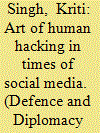

|
|
|
| 3 |
ID:
153404
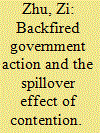

|
|
|
|
|
| Summary/Abstract |
This article discusses the interrelations between different episodes of contention in China through a case study of the Maoming anti-PX protests in 2014. Drawing on interviews and documentary data, the author specifies the spillover effect of previous anti-PX activism on the Maoming case. This article argues that preceding anti-PX protests helped bring about the Maoming protests, and explains how diffusion shaped protest dynamics in two aspects. First, it shows how local officials reacted to previous anti-PX episodes by taking pre-emptive measures designed to prevent mobilization in Maoming. However, this strategy backfired. Instead, it directly contributed to the anti-PX protests by facilitating cognitive liberation and activist networking. Second, this article shows how Maoming contenders also underwent a learning process. Previous anti-PX protests exerted an influence on the grievance framing in the Maoming protests and encouraged mobilization by increasing public expectations for success and legitimizing protest as a tactic. During the course of contention, Maoming protesters actively drew on their predecessors’ experiences, which shaped their own strategies accordingly.
|
|
|
|
|
|
|
|
|
|
|
|
|
|
|
|
| 4 |
ID:
140768


|
|
|
|
|
| Summary/Abstract |
The following article does not discuss various aspects of international cooperation on the political and strategic levels but considers the challenge of cross-cultural cooperation among service members in the field. Cooperation in a culturally diverse environment is influenced by various cultures and identifications (the national culture, military organizational culture, social identities). Based on the presumption that the culture is manifested through the values, rituals, symbols, practices, and language, the thesis about the existence of peace operations’ culture was tested. The main research questions were: (a) how are national and military cultures manifested in a peace operation?; (b) does the culture of a peace operation exist?; and (c) do service members of various nationalities identify themselves with a peace operation? The study was conducted among Italian and Slovenian service members deployed to at least one peace operation. The results show that a peace operation develops practices, values, symbols, rituals, and a common language. Hence we can speak of a peace operation’s culture. The service members’ identification with the peace operation is strong during the deployment; however, sources of identification vary depending on one’s position in the peace operation (i.e., national unit, multi-national HQ). Service members in HQs develop a strong sense of belonging to the multi-national working team, while the main source of common identity for bigger national units is the local environment.
|
|
|
|
|
|
|
|
|
|
|
|
|
|
|
|
| 5 |
ID:
140767


|
|
|
|
|
| Summary/Abstract |
The role of small states in international relations, aspiring to enter into international society as a credible actor, is often measured through their contribution to international security. Slovenia, as a small state, has presumed its ‘well-deserved place’ in the international community could be reached by becoming a trustworthy member of NATO. Among other things, this has meant aligning state policies with those of the political-military organization and so becoming a ‘like-minded’ member of the prestigious club. One of the steps Slovenia has done in this regard was the deployment of its civilian experts to the NATO-led missions to Kosovo and Afghanistan; they were integrated into the contingents of the Slovenian Armed Forces. With this, Slovenian civil-military cooperation in conflict and post-conflict areas has begun, following NATO’s request to contribute not only armed forces but also civilian experts. This article analyzes the development of civil-military cooperation in Slovenia and explores how has it evolved from relatively poorly planned and unorganized attempts to a more structured and better coordinated ‘business’ of a small state in fragile societies. The relationship between the Slovenian military and Slovenian civilian experts from the perspective of ‘being forced to work together’ within the stabilization efforts in Kosovo and Afghanistan is the main focus of this article. The article’s findings, built on interviewing and surveying of Slovenian military commanders and civilian experts, are relevant for a better understanding of small states’ behavior in international relations and military sociology in conflict and post-conflict zones.
|
|
|
|
|
|
|
|
|
|
|
|
|
|
|
|
| 6 |
ID:
148019


|
|
|
|
|
| Summary/Abstract |
The paper concerns to explore and analyse the close interrelationship between water and climate change, how water serves as a primary medium through which climate change influences the ecosystem of the Earth. Consequently, it affects livelihood and well-being of societies. Climate change is having potential to exacerbate a wide range of existing, interacting, non-climate threats to security as known as threat multiplier.
|
|
|
|
|
|
|
|
|
|
|
|
|
|
|
|
| 7 |
ID:
124674
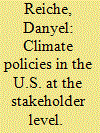

|
|
|
|
|
| Publication |
2013.
|
| Summary/Abstract |
This article analyzes how stakeholders are able to influence climate policy-making in the U.S.; emphasis is placed upon the most popular sports league in the United States, the National Football League (NFL). An empirical analysis of the 32 NFL franchises identifies pioneering clubs that have introduced ambitious green programs that include the utilization of renewable energies, the adoption of energy efficiency measures and carbon offsetting policies, as well as the facilitation of public transport and electric cars. Apart from environmental concerns, this paper identifies several drivers for pioneering actions: economic motives, pressure exerted by the local environment, public relations, and political incentives such as the promotion from the federal government's stimulus package. Finally, this article investigates the role that state actors, such as the Environmental Protection Agency, and non-state actors, such as the Natural Resources Defense Council, play in the innovation and diffusion processes of environmental programs in the NFL.
|
|
|
|
|
|
|
|
|
|
|
|
|
|
|
|
| 8 |
ID:
155950
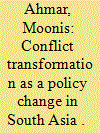

|
|
|
| 9 |
ID:
145365
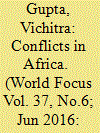

|
|
|
|
|
| Summary/Abstract |
In Africa, there is a dire need of cultural plurality sensitization so as to integrate all the ethnic groups and accommodate them giving a proper share in power structure. Modern and technological education is urgently required so that Africa is not dependent on foreign nations to explore their resources. They should be able to be their equal partners and shun their dominance. The resources, instead of being wasted on conflicts, may be utilized for development of Africa and the Africans could become the wealthiest persons.
|
|
|
|
|
|
|
|
|
|
|
|
|
|
|
|
| 10 |
ID:
148664


|
|
|
|
|
| Summary/Abstract |
Several factors contribute to or inhibit the “contagiousness” of regional conflict and irregular warfare, whether conducted at the interstate, extrastate, or intrastate level. Five broad drivers of the diffusion of regional conflict are (1) weak states, (2) anticipated power shifts, regional and domestic, (3) unstable and poorly controlled border regions, (4) large refugee flows, and (5) the religiously-based non-state militant campaign against the state as an organizing principle of world politics. These factors are both endogenous and exogenous to particular states and societies, and must be considered alongside the standard factors considered in international relations literature to be the basis of “dangerous state dyads:” geographic contiguity, absence of alliances, absence of an advanced economy, absence of a democratic polity, and absence of a regionally preponderant power. Two case studies illustrate this argument: the rise of Islamic State, and the awareness of the causes of contagion in regional conflict implicit in Israeli security policy.
|
|
|
|
|
|
|
|
|
|
|
|
|
|
|
|
| 11 |
ID:
138119


|
|
|
|
|
| Summary/Abstract |
This study focused on the experiences of a principal in developing a collaborative practice for teachers in his school. A qualitative research design was employed to determine the views of the principal in initiating and maintaining a collaborative culture in the primary school. A narrative analysis was used to analyse the data. The findings show the necessity of supportive leadership, how important it is for teachers to share their intellectual property and the benefit of creating supportive conditions for teacher collaboration. The study provides a tentative theoretical framework for a better understanding of the role of leadership in teacher collaboration and suggestions for teachers who would like to develop practical learning communities in their schools.
|
|
|
|
|
|
|
|
|
|
|
|
|
|
|
|
| 12 |
ID:
177171
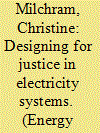

|
|
|
|
|
| Summary/Abstract |
In future urban energy systems, smart grid systems will be crucial for the integration of renewable energy. However, their deployment has moral implications, for example regarding data privacy, user autonomy, or distribution of responsibilities. ‘Energy justice’ is one of the most comprehensive frameworks to address these implications, but remains limited regarding smart grids, and regarding concrete guidelines for designers and policymakers. In this paper, we fill this gap by answering the following research question: How do design choices in smart grid projects impact energy justice? Thereby, four smart grid pilot projects are evaluated in a comparative qualitative case study research design. Data was collected through semi-structured interviews and a content analysis. Our findings contribute to the energy justice literature with insights regarding the design for distributive, recognition, and procedural justice. They underscore the importance of fairness in data governance, participatory design, user control and autonomy, technology inclusiveness, and the design for expansion and replication. Future research should explore the feasibility to govern smart grids as commons and the relationship between trust and perceptions of justice. We conclude with policy recommendations for funding future smart grid experiments and for facilitating the implementation of storage through electricity sector regulation.
|
|
|
|
|
|
|
|
|
|
|
|
|
|
|
|
| 13 |
ID:
142483
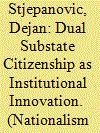

|
|
|
|
|
| Summary/Abstract |
This article analyzes the politics and constitutional position of the Brčko District of BiH, drawing on this case to inform several important debates in the field with regards to questions of federalism, citizenship, and electoral politics. The article shows that the condominium logic of territorial arrangement has profound implications for substate citizenship in Brčko. It argues that apart from territorial options and consociational institutional mechanisms substate citizenship is an important element of conflict management. Though often neglected in the literature, dual substate citizenship could be considered an instrument of conflict management and, as this article argues, as a model of institutional innovation in divided societies.
|
|
|
|
|
|
|
|
|
|
|
|
|
|
|
|
| 14 |
ID:
153405
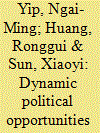

|
|
|
|
|
| Summary/Abstract |
While the literature on Chinese environmental politics tends to examine NGO actions and popular protests as two separate facets of environmental activism, such a tendency runs the risk of missing the linkages that have begun to emerge among environmental forces. This new phenomenon is highlighted with a case study of local opposition against the siting of an oil refining plant in Kunming through the lens of political opportunity theory. Two forms of linkages are identified, namely the linkages between local communities and local NGOs and the linkages between local and supra-local NGOs. These linkages emerged and developed through dynamic interactions between political opportunities and contentious actions. Citizen-initiated protests in Kunming pressured the local government to adopt a receptive attitude for the purpose of maintaining social stability, which paradoxically expanded political opportunities for NGO participation. The structural political environment of the locality indirectly facilitated collaboration between local and supra-local environmental NGOs by activating prior social networks among key NGO members. The analysis of the dynamic linkages among environmental forces reflects the prospects of a broader environmental movement and its relation to political contexts.
|
|
|
|
|
|
|
|
|
|
|
|
|
|
|
|
| 15 |
ID:
167863
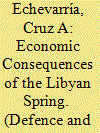

|
|
|
|
|
| Summary/Abstract |
In 2011 a wave of revolutionary movements, the so-called Arab Spring, spread in the Middle East and North Africa. Libya was one of the most affected countries, ending Gaddafi’s dictatorship after an international intervention and a civil war. This paper assesses the effects that this revolution had on Libyan economy. The analysis is made by means of the synthetic control method. Our estimates for the 2011–2014 period show (i) a cumulative loss in the growth rate of per capita real GDP of 64.15%; (ii) a cumulative loss in per capita real GDP of 56,548 dollars; and (iii) a cumulative loss in the aggregate real GDP of 350.5 billion dollars.
|
|
|
|
|
|
|
|
|
|
|
|
|
|
|
|
| 16 |
ID:
150633
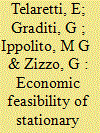

|
|
|
|
|
| Summary/Abstract |
Battery energy storage systems (BESSs) are expected to become a fundamental element of the electricity infrastructure, thanks to their ability to decouple generation and demand over time. BESSs can also be used to store electricity during low-price hours, when the demand is low, and to meet the demand during peak hours, thus leading to savings for the consumer. This work focuses on the economic viability of BESS from the point of view of the electricity customer. The analysis refers to a lithium-ion (Li-ion), an advanced lead-acid, a zinc-based, a sodium-sulphur (NaS) and a flow battery. The total investment and replacement costs are estimated in order to calculate the cumulated cash flow, the net present value (NPV) and the internal rate of return (IRR) of the investment. A parametric analysis is further carried out under two different assumptions: a) varying the difference between high and low electricity prices, b) varying the peak demand charges. The analysis reveals that some electrochemical technologies are more suitable than others for electric bill management applications, and that a profit for the customer can be reached only with a significant difference between high and low electricity prices or when high peak demand charges are applied.
|
|
|
|
|
|
|
|
|
|
|
|
|
|
|
|
| 17 |
ID:
149312
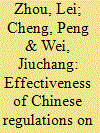

|
|
|
|
|
| Summary/Abstract |
To assess the effectiveness of Chinese regulations on occupational health and safety, this study provides an exploratory method by applying multiple interrupted time series (MITS) analysis. Taking coal mine safety in China as a case study, this article analyzes the background of the coal industry, especially during the period 1980–2009, and selects three typical pieces of national legislation specific to mining and work safety as the interventions. The data relevant to coal mine safety and the ‘third variables’ were collected to empirically support the study. The estimated results indicate different effects of these interventions on state-owned enterprise (SOE) mines and township and village enterprise (TVE) or small mines. Specifically, though the mortality rate in SOE mines is on a downward trend, these interventions have had no significant effect on it. However, only the 2002 act significantly reduced the mortality rate per million tons in TVE mines. The effectiveness of the interventions seems to depend on certain conditions, such as technology, administration and socioeconomic environment and type of coal mine.
|
|
|
|
|
|
|
|
|
|
|
|
|
|
|
|
| 18 |
ID:
179558


|
|
|
|
|
| Summary/Abstract |
North Korea today is a most unusual post-socialist state. Market actors and market prices are integral to economic life, but private property remains illegal, and private enterprise outside the household is de jure non-existent. In such an institutional context, some market processes are more autonomous in relation to the state, while others are more embedded within state structures. In this article, we offer a theoretical account of the shape that North Korea's market economy has taken, developed from a set of fishing industry case studies. We note four broad categories of enterprises: closely embedded, loosely embedded, semi-autonomous, and autonomous. By relative autonomy/embeddedness we mean control over fixed assets, cash flow, and operational decisions such as wage and price setting. We postulate three major determinants of embeddedness/autonomy: (1) relative strategic resource scarcity between state and market actors, (2) monitoring costs, and (3) institutional evolution that reflects these realities, though to varying extents.
|
|
|
|
|
|
|
|
|
|
|
|
|
|
|
|
| 19 |
ID:
134441
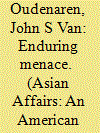

|
|
|
|
|
| Summary/Abstract |
Since the 1980s, Hong Kong triad societies have evolved from hierarchical, pyramidal organizations to loose, compartmentalized syndicates that retain a modicum of hierarchy. Changes in triad organization and modus operandi occurred in response to stringent anti-organized crime measures enacted in Hong Kong. However, organizational evolution has facilitated triad transplantation to China and improved triads’ ability to engage in transnational crime. Triads have exploited favorable circumstances in China: prevalent corruption, rapid urbanization, and high demand for illicit goods and services. This paper includes two case studies of the Sun Yee On triad. The first examines Sun Yee On's localized activity by tracing the evolution of one Shenzhen area chapter. The second case study examines Sun Yee On's role as a supplier of methamphetamine precursor chemicals to Mexico's Sinaloa cartel. Sun Yee On exemplifies how modern triads have become hybridized, assuming attributes of both local Chinese organized crime and transnational criminal networks.
|
|
|
|
|
|
|
|
|
|
|
|
|
|
|
|
| 20 |
ID:
051096
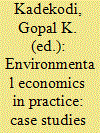

|
|
|
|
|
| Publication |
New Delhi, Oxford University Press, 2004.
|
| Description |
xxv, 372p.
|
| Standard Number |
0195666178
|
|
|
|
|
|
|
|
|
|
|
|
Copies: C:1/I:0,R:0,Q:0
Circulation
| Accession# | Call# | Current Location | Status | Policy | Location |
| 047908 | 333.7/KAD 047908 | Main | On Shelf | General | |
|
|
|
|
|
|
|
|
|